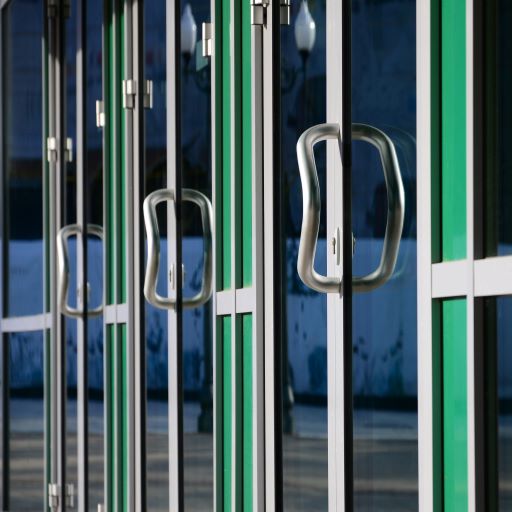Best automatic swing door operators

If you’re planning on installing automatic swing doors in your building, then your choice of door operator will be a key consideration. These are mechanical devices that are used to automate the opening and closing of swing doors. They are designed to be a reliable, robust and effective means by which to widen accessibility. Automated swing doors make hands-free entry simple and make it easier for people with disabilities to access your business.
Automatic swing door operators will typically consist of a motor and a variety of mechanical components that are installed on the door and the frame. These components will be connected to a control system that will allow for the door operation to be timed or overridden. When activated, the motor will drive the doors to open or close in a controlled, smooth and safe motion.
Why are automatic swing door operators important?
Automatic swing door operators make door automation possible. They improve accessibility and help to promote a more inclusive environment. They make entering and exiting your building more convenient, eliminating the need for manual effort. They often incorporate low-energy technology which helps to reduce energy consumption and lowers costs. This can make a significant difference in larger buildings and those that have frequent foot traffic.
Automatic swing doors reduce some of the risks associated with manual door operation such as pinched fingers and broken bones. Because automatic swing doors eliminate the need for manual contact with doors, swing door operators reduce the risk of infection transmission.
What are the different kinds of automatic swing door operators?
There is a range of different kinds of swing door operators, each of which is more suitable for different contexts and installations:
Hydraulic Operators
Hydraulic automatic swing door operators use hydraulic power to control the opening and closing of doors. They work by using a hydraulic cylinder, which is filled with a liquid under pressure, to apply force to the door. When the door is triggered to open, the hydraulic cylinder extends, pushing the door open. When the door is triggered to close, the cylinder contracts, pulling the door closed.
The hydraulic mechanism can be adjusted to control the speed of the door's movement, ensuring that it opens and closes at a pace that is safe and comfortable for users. Unlike other types of automatic door operators, which can sometimes make a clunky noise when opening or closing, hydraulic operators tend to be much quieter and more refined in their movement.
Pneumatic Operators
Pneumatic automatic swing door operators use compressed air to control the opening and closing of doors and are simple and easy to use. They work by using a pneumatic cylinder, which is filled with compressed air, to apply force to the door. When the door is triggered to open, the pneumatic cylinder extends, pushing the door open. When the door is triggered to close, the cylinder contracts, pulling the door closed.
Unlike hydraulic and electro-hydraulic operators, which require a more complex system of pumps, valves, and electrical components, pneumatic operators have fewer moving parts and are less likely to experience problems.
This simplicity makes them a relatively inexpensive choice and a good choice for budget-conscious customers. However, compared with other types of operators, they can be less smooth and noisier in their operation. They also require a reliable source of compressed air to operate.
Electro-magnetic Operators
Electro-mechanical automatic swing door operators use an electric motor to drive a mechanical mechanism that opens and closes the door. Electrical energy is converted into mechanical energy which is then used to move the door. They’re sometimes considered a practical and more reliable system than hydraulic operators which can be liable to fail or leak.
Electro-mechanical operators have fewer moving parts and are less likely to experience problems. As a result, they are often easier to maintain and repair, and use a more straightforward mechanical mechanism. Electro-mechanical operators also consume relatively low amounts of electricity compared to other types of automatic door operators, making them an environmentally friendly as well as cost-effective option.
Electro-hydraulic Operators
Electro-hydraulic automatic swing door operators combine the power of hydraulic systems with the precision and control of electrical systems. They use an electric motor to power a hydraulic pump, which provides the force necessary to open and close the door.
They have the quiet, smooth operation of hydraulic operators, as well as the reliability and energy efficiency of electro-mechanical operators. It’s possible to adjust them to work effectively with a wide range of door weights and sizes, making them suitable for heavy-duty commercial settings and lower foot traffic residential installations.
Because they combine both hydraulic and electric power, they can often be more powerful than other kinds of systems. However, this combination of hydraulic and electrical systems will usually mean they are both more expensive and more complex than other types of automatic door operators.
Magnetic Lock Operators
Magnetic lock automatic swing door operators use an electromagnet to lock and unlock the door. The electromagnet is typically located on the door frame, and when the door is in the closed position, the magnetic field holds the door securely in place. When the door is triggered to open, the magnetic field is released, allowing the door to swing open
These are often the first choice when it comes to security because when the door is locked, it is virtually impossible to open without first releasing the magnetic field. Magnetic lock operators are also a low-maintenance option, have fewer moving parts and are less likely to experience problems.
Belt Drive Operators
Belt drive automatic swing door operators use a belt and pulley system to control the opening and closing of doors. The belt is attached to a motor and runs along a series of pulleys to transfer the motor's power to the door. When the door is triggered to open, the motor turns, causing the belt to move and open the door. When the door is triggered to close, the motor turns in the opposite direction, closing the door.
They are a relatively low-maintenance option and have a quiet operation. However, they provide less power than other types of swing door operators and aren’t compatible with heavier doors.
Choosing the right swing door operator for your installation
Choosing the right automatic swing door operator for your installation requires consideration of factors such as door weight and size, security requirements, budget, and the environment in which the door will be installed.
If you have any doubts, please speak to the experienced team at Safetell and we will advise on what might be the best system for your installation. We are specialist automatic swing door, automatic sliding door and automatic door servicing advisors. Visit our contact us page or give us a ring on 01322 428 971
.png?width=3047&height=647&name=Safetell%20Master%20Logo%20CMYK%20(1).png)

